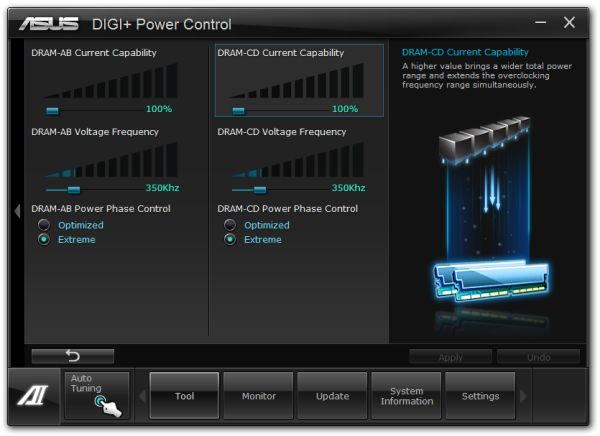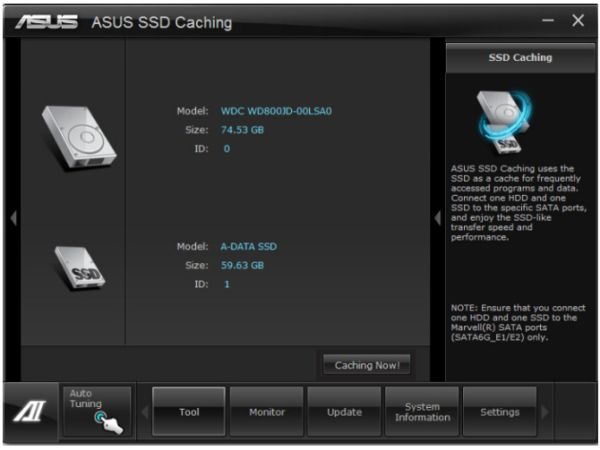Sandy Bridge-E and X79 – The ASUS P9X79 PRO Review
by Ian Cutress on November 14, 2011 3:01 AM EST- Posted in
- Motherboards
- Asus
- X79
Board Features
| ASUS P9X79 Pro | |
| Size | ATX |
| CPU Interface | LGA2011 |
| CPU Support | Intel Second Generation Core i7 Sandy Bridge-E |
| Chipset | Intel X79 |
| Base Clock Frequency | 100.0 - 100.3 MHz |
| Core Voltage | Auto, offset and manual, 0.8 V to 1.7 V |
| CPU Clock Multiplier | Auto, 12x to 57x |
| DRAM Voltage | Auto, 1.20 V to 1.99 V |
| DRAM Command Rate | Auto, 1T to 3T |
| Memory Slots |
Eight DDR3 DIMM slots supporting up to 64 GB Up to Quad Channel Support for DDR3, 800-2666 MHz |
| Expansion Slots |
2 x PCIe Gen 3 x16 2 x PCIe Gen 3 x8 2 x PCIe Gen 2 x1 |
| Onboard SATA/RAID |
2 x SATA 6 Gbps, Support for RAID 0, 1, 5, 10 4 x SATA 3 Gbps, Support for RAID 0, 1, 5, 10 |
| Onboard |
2 x SATA 6 Gbps (Marvell) 4 x SATA 3 Gbps (PCH) 2 x SATA 3 Gbps (PCH) w/ SSD Caching 6 x Fan Headers 1 x Front Panel Header 1 x Front Panel Audio Header 1 x S/PDIF Out Header 4 x USB 2.0 Headers 1 x USB 3.0 Header 1 x EPU Switch 1 x TPU Switch Power / Reset / Clear CMOS Buttons + Debug LED |
| Onboard LAN | Intel Gigabit 82579V |
| Onboard Audio | Realtek ALC898 |
| Power Connectors |
1 x 24-pin ATX connector 1 x 8-pin 12V connector |
| Fan Headers |
2 x CPU Fan Header 4 x Chassis Headers |
| IO Panel |
6 x USB 2.0 4 x USB 3.0 1 x BIOS Flashback Button 1 x Intel Gigabit Ethernet 1 x Optical S/PDIF Out Connector 2 x Power eSATA 6 Gbps Bluetooth v2.1 Audio Jacks |
| BIOS Version | 0709 |
| Warranty Period | 3 Years |
The Intel NIC is very welcome on a high end platform, as well as one of the later models of Audio Codec by Realtek, which is represented in the DPC Latency performance. The BIOS Flashback feature (Update BIOS via USB without CPU or DRAM) is an excellent feature I hope ASUS ports to all future chipsets, as well as the SSD Caching option even though it is not part of the X79 specifications. Six fan headers is always good, as well as Debug LED and power/reset buttons, however as mentioned previously I would have liked another Ethernet port.
As always, ASUS motherboards have a 3 year warranty.
In The Box
IO Shield
Manual
Driver CD
1 x Long SLI Cable
1 x Rigid Tri-SLI Connector
6 x SATA cables, locking, right angled
Q-Connectors
While ASUS have spent money on the cables and the SLI connectors, on a product at this price, I would have liked to see a long CrossFireX cable and a USB 3.0 front bracket.
Software
Software installation, as always with ASUS, is straightforward. Clicking Install-All on the CD menu under the Driver section does the drivers, and then once again under the Software for software. ASUS bundles Google Chrome and Norton Antivirus with the CD as well which annoyingly ask to be installed – users have to deselect them if they do not want them. Daemon Tools Pro is also on the CD, though users have to install it individually.
The main stalwart of ASUS software is still here, under a slightly redesigned ASUS AI Suite II. With the depth of X79 and all the new features ASUS have added, we have to get to grips with the whole software. Overclocking function is nothing spectacular here, with Auto Tuning and slider adjustment being identical to previous implementations. With the advent of DIGI+ VRM for the memory, we now get options to adjust this, as well as the DIGI+ for the CPU.
Energy efficiency options also get a revamp in their modes, and in terms of fan controls, each of the four chassis fan headers are double-ramp adjustable, and the two CPU fan headers act under the one control.
The two new areas of ASUS brand technology come in the form of ASUS USB 3.0 Boost, and ASUS SSD Caching. Let us go over each one in turn.
ASUS USB 3.0 Boost
Readers of this year’s content may cast their minds back to the several ASRock boards I have reviewed, and their XFast USB software. This was a simple bit of software that modified and optimized the Windows7 USB driver to allow for faster operation. ASUS have gone in a similar theme, but taken it several steps further.
On the simple end, there are multiple USB protocols to use. Windows, by default, uses BOT – a simple linear process protocol for file transfer. By a simple rewrite of the driver, such as the ASRock implementation, a motherboard manufacturer can implement a ‘Turbo’ mode, which acts like a more multithreaded environment.
Now, if the USB device or enclosure has certain classes of controllers (LucidPORT USB300-REV2, ASMedia ASM1051E, ASMedia ASM1051U, ASMedia ASM1054), a protocol known as UASP (USB Attached SCSI Protocol) can be implemented. This protocol is more efficient, and allows multiple, concurrent commands, rather than the linear BOT sequence. This is what USB 3.0 Boost is aimed at.
Initially, each USB 3.0 device will need to be set to Turbo or UASP as required, but devices are remembered for repeat use. Unfortunately, I do not have access to a device to test this UASP performance; however I was able to see it in action at a recent ASUS event.
ASUS SSD Caching
Users of Intel’s Z68 Smart Response Technology that were dismayed when SRT was not a part of the X79 specifications will be overjoyed to see something similar to Intel’s operation on ASUS’ X79 range. By placing two compatible drives (typically a mechanical HDD and a formatted SSD) in the appropriate SATA ports, the software and hardware implementation will let the SSD act as a cache, in order to improve loading times to the mechanical HDD, just like Intel’s RST.
The potential here is possibly using any extra RAM as a cache. With the abundance of 4x4GB kits for use in such a system, from my own personal experience, almost half of that would never be used – the most memory I’ve ever used is 7.9 GB, which included a hundred or so internet tabs, background software, and whilst playing F1 2010 at full settings. If ASUS were to license a RAMDisk software technology to allow users to create a RAMDisk, and then use that in an SSD caching technique, then we are on to a winner. Even better if a user has decided to fill up the memory slots with 32 GB. Admittedly, this would be lost every time the system is rebooted, and would have to be remade, but for users who leave their system on all the time for various reasons, it could provide useful.





















55 Comments
View All Comments
mailman65er - Monday, November 14, 2011 - link
No SSD Caching (no intel RST)?Just get a Synapse Cache SSD - the included Dataplex cache software outperforms Intel caching anyway... No problem.
jmelgaard - Tuesday, November 15, 2011 - link
Pft... Who needs SSD caching anyways?!?...I have more than enough space on my 3x240GB Vertex 3 + 2x120GB Vertex 2 + 80GB Intel X25-M r2.
:P...
ASUSTechMKT - Wednesday, November 16, 2011 - link
LOL you are lucky man. Keep in mind though you do get to maintain Trim in SSD Caching but while not in raid.kvanje - Monday, November 14, 2011 - link
Tom's just showed in a test that Skyrim becomes CPU-bound at a certain point, so that might make a good addition to your benchmarks in this case.ts1973 - Monday, November 14, 2011 - link
Why no comparison with another X16-X16 Intel platform, most notably the X58-990X combo ? Gaming tests and value for possible upgrade are not very convincing this way.futurepastnow - Monday, November 14, 2011 - link
Will Sandy Bridge -EP Xeon processors work in X79 desktop motherboards?ASUSTechMKT - Monday, November 14, 2011 - link
Our P9X79 WS is qualified to support Xeon series CPUs. Other baords may potentially offer microcode support but will not be officially validated for use with Xeon CPUs.ven - Monday, November 14, 2011 - link
still relying on heat sinks,heat pipes and fans I expected some change from the board manufactures for this platform at least from you Asus,Disappointed......... Please move Forward & show us the glimpse of the future cooling technologies .And also why intel has downgraded from QPI to DMI ,yes of course PCIe lanes are moved to Processor but for this is such a high end & pricy platform QPI should have opted.
Great work Asus Iam fan of your color theme and UEFI implementation.Board looks great. At present proud owner of Maximus iv Gene-Z, Iam waiting for some mATX boards
ASUSTechMKT - Monday, November 14, 2011 - link
We are always looking into other aspects in regards to cooling / dissipation technologies. Thanks for the feedback depending on certain factors more advanced technologies can considerably increase cost or time to produce ( Such as when we used CeraM!X on our TUF series motherboard. Regardless we look for other aspects to improve upon such as more advanced and efficient VRM designs with more options on temperature and current handling or loading.Thanks for the great feedback it is appreciated and watch out soon on the MATX front!
alpha754293 - Monday, November 14, 2011 - link
If populating all 8 DIMMS is going to drop it down to DDR3-1333 speeds, that means that you can just BUY DDR3-1333 8 GB DIMMs for as little as $75 a pop (and that's ECC Registered server RAM too!). That means for a system with 64 GB, you're only look at $600, which is almost $300 less than the top-of-the-line (currently, at launch) SNB-E processor you can buy."There are issues to the memory that a lot of people will consider – does anyone ever need 64 GB of memory? Even if it were populated with relatively cheaper 4 GB sticks, does anyone ever need 32 GB of memory?"
With memory being relatively cheap these days, would most people "need" it? No, you're right, probably not.
But if I can get a 32 GB super fast RAM drive, that extra $300 might be worth it. If you have a game or two that's ridiculously large and takes a fair bit of time to load, the RAM drive would be well served. Or if you start/restart large apps (like Photoshop CS5) often; again, the RAM drive could come in handy.
And when you can have that much memory for less than the cost of the processor, it's worth considering -- IF you can use it.